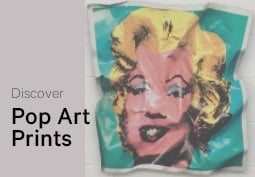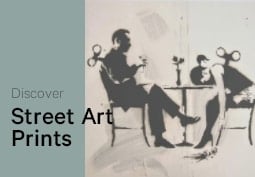Articles and Features
Agents of Change: Silk Screen
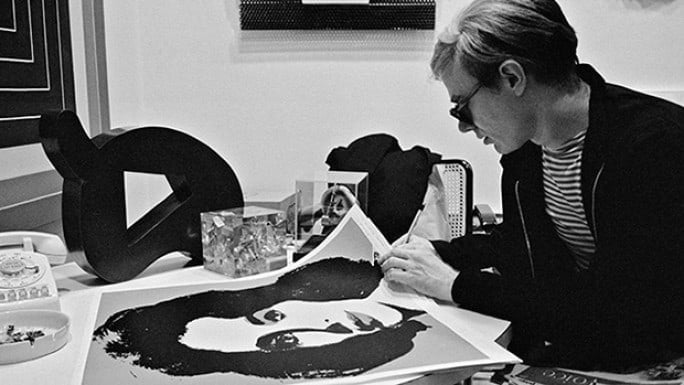
By Shira Wolfe
“I tried doing them by hand, but I find it easier to use a screen. This way, I don’t have to work on my objects at all. One of my assistants or anyone else, for that matter, can reproduce the design as well as I could.” – Andy Warhol on the silk screen method
What is a Silk Screen Print and Silk Screen Printing?
Silk screen printing, also known as screenprinting or serigraphy, is a sophisticated stencilling technique for surface printing in which an ink- or paint-blocking stencil is applied to a screen. Ink or paint is wiped across the screen and pressed through using a rubber tool called a squeegee, so the ink or paint selectively passes through to the printing surface. Most commonly, a fine mesh screen is stretched tightly over a wooden frame above a piece of paper. The screen, which acts as the stencil, is traditionally made of silk, from which the name silk screen printing derives. For a long time, silk was the only material that had a small enough weave for the silk screen process. However, different materials such as cotton, nylon and steel wire can now also be used.
Different Methods of Silk Screen Printing
There are many different methods of silk screening, but two major commercial techniques account for about 95% of all the screen work: the hand-cut film stencil technique and the photographic technique. Additionally, techniques such as the tusche method, the block-out method and the cut-paper stencil method are often used for fine-art printing. The simplest of these methods is the block-out method. For every colour an artist wishes to apply, a separate screen has to be used, with a different area blocked out every time.
The Block-Out Method
The block-out method consists of making a drawing or cut-out on the screen, and then coating the areas of the screen that are not to be printed with a sealer, like lacquer, shellac or glue, to prevent ink or paint clinging to those parts. Ink or paint is pushed through the screen onto the chosen material, using a rubber blade known as a squeegee.
Lithographic Tusche
Another option is to use lithographic tusche (a grease-based ink) to paint the design on the screen. The entire screen is then covered with glue. Next, once the glue coating has dried, kerosine is wiped over the surface of the screen to remove the tusche from the parts where the artist has drawn.
Hand-Cut Film Stencil Technique
The process of the hand-cut film stencil is as follows: a piece of film, at least 1 inch larger than the artwork, is cut out. The film is then taped over the design on the work surface. The next step is to cut around the design, making sure not to cut into the backing sheet. The parts that should be printed are then lifted away, and the film that is left will seal off the rest of the screen, preventing ink from passing through. The film is then adhered to the screen, after which the printing process can commence.
The Photographic Technique
There are two methods of photographic screen printing. In the direct method, photo-sensitive film or liquid emulsion is applied to the screen and allowed to dry. Next, it is exposed to the artwork (the film positive) with a proper light source. The indirect method consists of first exposing the photo-sensitive film to the artwork, then developing it in developing solution or water, and applying it to the screen while still wet. This method only works for solvent-based inks.
The History and Development of Silk Screen Printing
The origins of silk screen printing can be found in early prints, woodcuts and block prints of the Chinese Song Dynasty (960 AD – 1279 AD). In the 15th and 16th centuries, the Japanese often used stencils on cotton and silk for clothing and decorations. The painstaking process Japanese printmakers went through, which involved gluing a spider-like network of human hair across the openings of oil-treated heavy paper sheets, can be seen as the antecedent of the modern silk screen method. Yet the silk screening process as we know it today originated in the early 1900s. The Englishman Samuel Simon first patented the modern silk screening process in 1907. He used a bristle brush, instead of a squeegee, to force the paint through the silk. Silk screening as a commercial craft originated in America. The American John Pilsworth patented multi-coloured screen printing in 1914. During World War I, commercial screen printing became immensely popular for printing flags and advertising banners. Though the method became popularised, the results obtained still lacked quality and uniformity compared to lithography and the letterpress, so it still wasn’t widely used for advertisements of high-level merchandising.
A milestone was reached in 1929, when a screen printer named Louis F. D’Autremont developed a knife-cut stencil film tissue, which was patented by his associate A. S. Danemon. The film tissue was named Profilm. This knife-cut film tissue greatly improved the ragged, unsharp quality of the prints that was before associated with silk screening. This was not the first time in history that silk screen prints had been made photographically, but the photographic method was arduous and undeveloped. The development of Profilm pushed the process forward. Several years later, Joe Ulano developed Nufilm, which was easier to cut, adhered better to the silk, and was more efficient than Profilm.
Artists first started using the silk screen method in the 1930s in the USA, at which point they also coined the term “serigraphy,” in order to distinguish the artistic use of silk screen printing from the more commercial, industrial use. However, it was in the 1960s, during the period of Pop Art, that the silk screen method really took the world by storm.
“The reason I’m painting this way is that I want to be a machine, and I feel that whatever I do and do machine-like is what I want to do.” – Andy Warhol
Silk Screen Printing in the 1960s – Warhol and Pop Art
In the 1960s, Pop Artists like Andy Warhol, Roy Lichtenstein, Robert Rauschenberg, Richard Hamilton and Peter Blake made extensive use of the silk screen method, thereby elevating it to an important art form in itself which became widely used by artists all over the world. Andy Warhol had a background in commercial art, and therefore felt a particular affinity to silk screening. Warhol and Rauschenberg furthered the technique by printing a design onto a canvas, in order to serve as the basis of a painting.
In an interview with Gene Swenson of Art News, Warhol famously said: “The reason I’m painting this way is that I want to be a machine, and I feel that whatever I do and do machine-like is what I want to do.” Warhol was attracted to the idea that all evidence of the artist’s hand was eliminated by this factory-style, mass-produced art production. His dollar bill paintings from 1962 are Warhol’s first attempts at silk screen printing. He used his own drawings as the basis, but wasn’t really satisfied with the result. But soon enough, he learned that he could also use photographs as the basis for his silk screen prints, which produced a much sharper image that wasn’t too sharp – just the way he liked it. It’s this photographic silk-screen method that Warhol continued to use extensively throughout his career. He developed his own technique by combining hand-painted backgrounds with photographic silk screen printed images.
Warhol was fascinated by fame and popular culture, and produced a great deal of silk screen prints using images of celebrities, such as Marilyn Monroe, Elizabeth Taylor, Jackie Kennedy and Elvis Presley. He experimented with multiplications of the silk screens in different colours, investigating the commodification of fame.
Iconic Artworks Made with the Silk Screen Method
1. Andy Warhol’s “Marilyn” (1967)
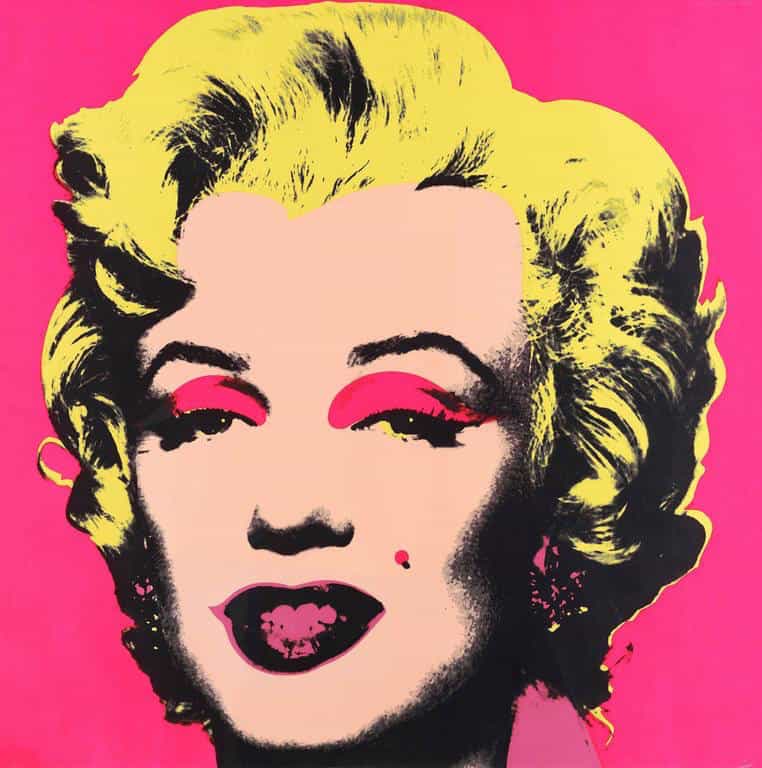
Just a few years after the death of Marilyn Monroe, Andy Warhol created his series of Marilyn silk screens. He used the same publicity still of the actress that he had previously used for paintings. Each of the images was printed from five screens. One screen carried the photographic image, and the other four were for the different areas of colour. Warhol commented on the repetition that he worked with, saying: “The more you look at the same exact thing, the more the meaning goes away, and the better and emptier you feel.”
2. Roy Lichtenstein’s “Brushstrokes” (1965)
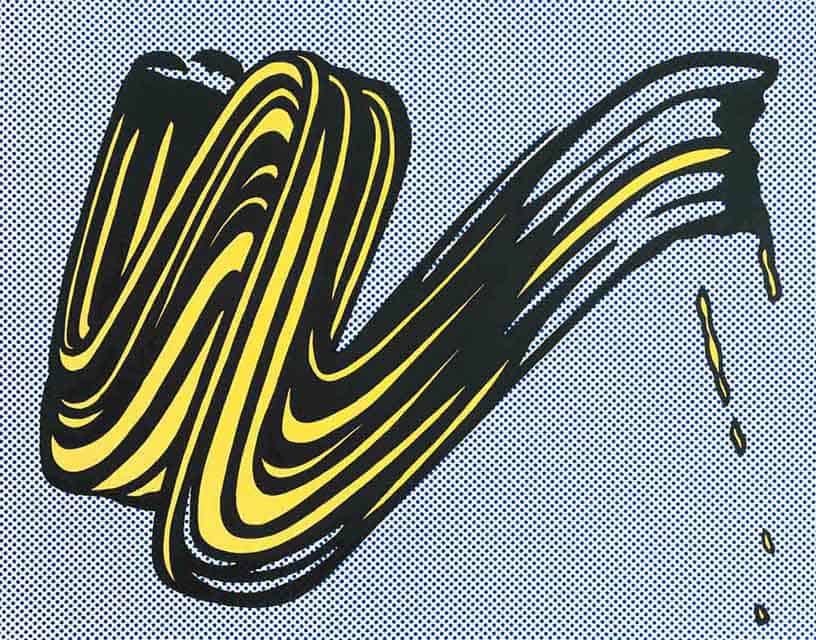
In 1965-66, Roy Lichtenstein made a series of screen prints entitled “Brushstrokes,” depicting enlarged brushstrokes. Lichtenstein here made a direct comment on the elevated content and loaded brushwork of Abstract Expressionism. The brushstroke, which is the token of the artist’s personal expression, is depersonalised. Lichtenstein screenprinted the motif onto paper, creating the effect of everyday advertising or publishing.
3. Peter Blake’s “Love Me Do” (2004)
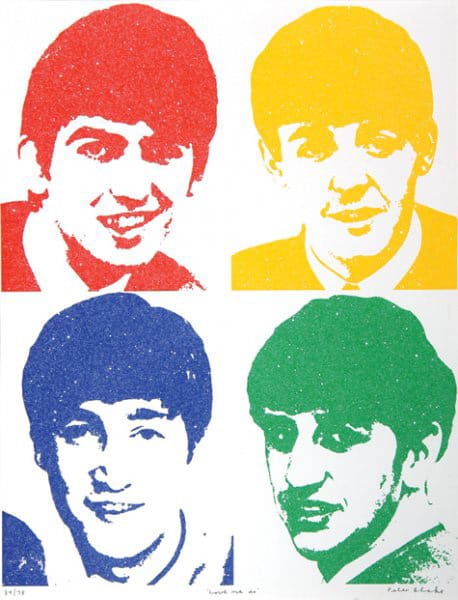
Peter Blake is one of the most famous British Pop Artists, who became known for doing the artworks on The Beatles album Sgt. Pepper’s Lonely Hearts Club Band. In 2004, he took photographs of the four Beatles from that album, and made 75 silk screen prints, with each Beatle in a different colour and embellished with diamond dust. He named the prints “Love Me Do,” after a Beatles song.
How is Silk Screening Being Used in Art Today?
Silk screen printing remains a popular technique among fine artists, commercial printers, manufacturers, fashion designers and commercial artists today. Due to the fact that almost any flat surface can be printed on, ranging from paper and textile to ceramics, wood, glass, metal and plastic, silk screening offers endless possibilities and remains a widely-used method.
Some of the most iconic images of our time were made using the silk screen method. Think, for example, of Shepard Fairey’s 2008 HOPE poster of Barack Obama. Though the poster wasn’t the official image of the Obama campaign, it certainly was its symbol. Initially conceived as a poster, it soon evolved into a stencil, which was acquired by the Smithsonian Institution’s National Portrait Gallery.

FAQ
Silk screen printing, also known as screenprinting or serigraphy, is a stencilling technique for surface printing in which an ink- or paint-blocking stencil is applied to a screen and ink or paint is pushed through to create a design.
When was silk screen printing developed?
The silk screen print as we know it today was first patented in 1907. However, people were already working with forerunners of this technique in 15th-16th century Japan, and during the Chinese Song Dynasty (960 AD – 1279 AD).
Who are some of the most important artists working with silk screening?
Andy Warhol, Robert Rauschenberg, Roy Lichtenstein, Richard Hamilton and Peter Blake.
Relevant sources to learn more
For a comprehensive history of silk screening
The Complete Book of Silk Screen Printing Production by J.I. Biegeleisen

